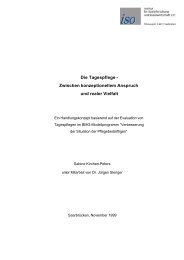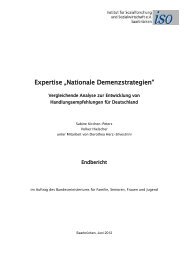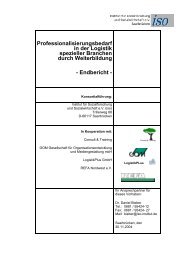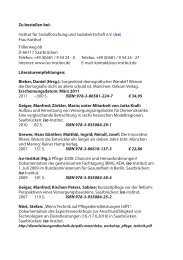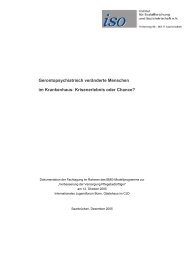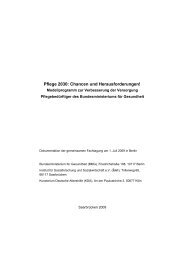iso-NEWS - Institut für Sozialforschung und Sozialwirtschaft eV
iso-NEWS - Institut für Sozialforschung und Sozialwirtschaft eV
iso-NEWS - Institut für Sozialforschung und Sozialwirtschaft eV
Erfolgreiche ePaper selbst erstellen
Machen Sie aus Ihren PDF Publikationen ein blätterbares Flipbook mit unserer einzigartigen Google optimierten e-Paper Software.
Ingrid Matthäi: ’Managing Diversity’<br />
__________________________________________________________________________________________<br />
der to improve equal conditions for both<br />
genders. The more comprehensive concept<br />
of ‘managing diversity’, indeed, goes<br />
far ‘beyond race and gender’ (Thomas<br />
1992) - it reflects the social process of individualization<br />
and pluralism in society as<br />
well (Beck 1986) when valuing individuality<br />
as a resource. Meanwhile ‘homogenous’<br />
oriented personnel policies interpret individuality<br />
as a ‘deficiency’ individuals must<br />
overcome and adapt to the (‘monocultural’)<br />
organization. ‘Managing diversity’<br />
means re-defining personnel policies<br />
switching from a ‘homogenous’ ideal to a<br />
‘pluralistic’ view.<br />
Therefore it is no surprise that nowadays<br />
the definition of ‘diversity’ includes a<br />
broader approach with more dimensions<br />
of variety, especially the soft factors. But<br />
there is no unique or global definition of<br />
diversity. Besides the ‘hard factors’ that are<br />
‘observable differences’ like age, gender,<br />
race or disabilities it focuses the so-called<br />
‘soft factors’ or ‘unobservable differences’<br />
like educational or social backgro<strong>und</strong>,<br />
religion, language, life styles, work status,<br />
sexual orientation, diversity in values or<br />
diversity in skills and knowledge. Diversity in<br />
general refers to any mixture of items<br />
characterized by differences and similarities<br />
between human beings. Therefore<br />
diversity is not synonymous with differences<br />
but encompasses both differences and<br />
similarities. This is a crucial distinction. It<br />
means that when you are making managerial<br />
decisions, you no longer have the<br />
option of dealing only with the differences<br />
or similarities present in the situation, instead<br />
you must deal with both simultaneously.<br />
But a very broad or extensive definition<br />
often is not very useful for implementation<br />
56<br />
<strong>iso</strong>-Mitteilungen Nr. 3/August 2004<br />
in companies (Sepeheri/Wagner 2002,<br />
Thomas 1996). Before they adopt this concept<br />
managers have to define the goals<br />
and must specifiy the dimensions in question.<br />
Which kinds of diversity exist in the<br />
company and which of them are worthiest<br />
of attention - gender, race, nationality,<br />
age, skills or others? A diverse workforce<br />
does not inevitably generate advantages<br />
over homogenous groups. There might be<br />
even some risks because differences on<br />
some dimensions could probably lead to<br />
fragmentation or segregation. Excessive<br />
orientations on heterogeneity might also<br />
lead to an ‘overshooting’ unable to be<br />
managed efficiently any longer. Too much<br />
diversity could lead to conflicts, confusion<br />
and social segregation because an increasingly<br />
diverse workforce is variously<br />
viewed as opportunity, threat or problem.<br />
Therefore the need for diversity must be<br />
balanced with the need for organizational<br />
coherence and unity in action to provide<br />
competitive edge. A good balance is best<br />
when neither excessive diversity nor excessive<br />
homogeneity is present (Cox/Blake<br />
1991). ‘Managing diversity’ is the ability of<br />
the company to manage a diverse workforce<br />
so that the potential advantages of<br />
diversity are maximized while its potential<br />
disadvantages are minimized. Using ‘managing<br />
diversity’ as a management concept<br />
requires instruments, practices, tools<br />
and systems that are flexible to respond<br />
the individual as a focus of organizational<br />
change. The following chart (fig. 3) shows<br />
the different levels of ‘doing diversity’, the<br />
specific goals and the tools for implementation<br />
in a company (Cox 1991; Krell 2002).




